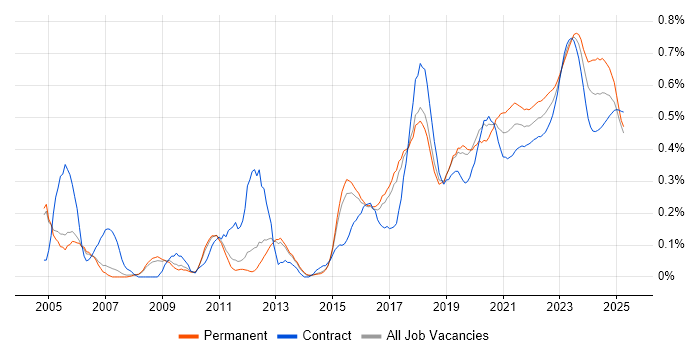Security Analyst
UK > Work from Home
The median Security Analyst salary for remote/hybrid work is £55,000 per year, according to job vacancies posted during the 6 months leading to 4 January 2026.
The table below compares current salary benchmarking and summary statistics with the previous two years.
|
|
6 months to
4 Jan 2026 |
Same period 2025 |
Same period 2024 |
| Rank |
305 |
329 |
299 |
| Rank change year-on-year |
+24 |
-30 |
+142 |
| Permanent jobs requiring a Security Analyst |
66 |
126 |
192 |
| As % of all permanent jobs with remote/hybrid work options |
0.44% |
0.76% |
0.92% |
| As % of the Job Titles category |
0.47% |
0.79% |
0.96% |
| Number of salaries quoted |
49 |
71 |
175 |
| 10th Percentile |
£41,250 |
£40,000 |
£38,500 |
| 25th Percentile |
£48,165 |
£47,059 |
£47,000 |
| Median annual salary (50th Percentile) |
£55,000 |
£60,000 |
£55,000 |
| Median % change year-on-year |
-8.33% |
+9.09% |
+4.76% |
| 75th Percentile |
£60,000 |
£67,500 |
£65,000 |
| 90th Percentile |
£70,000 |
£77,750 |
£76,250 |
| UK median annual salary |
£55,000 |
£62,500 |
£55,000 |
| % change year-on-year |
-12.00% |
+13.64% |
+3.77% |
For comparison with the information above, the following table provides summary statistics for all permanent IT job vacancies with remote/hybrid work options. Most job vacancies include a discernible job title that can be normalized. As such, the figures in the second row provide an indication of the number of permanent jobs in our overall sample.
| Permanent vacancies in Work from Home with a recognized job title |
14,055 |
16,038 |
20,083 |
| % of permanent jobs with a recognized job title |
93.55% |
96.16% |
95.89% |
| Number of salaries quoted |
9,062 |
9,746 |
16,367 |
| 10th Percentile |
£30,000 |
£35,000 |
£36,250 |
| 25th Percentile |
£41,250 |
£46,250 |
£45,398 |
| Median annual salary (50th Percentile) |
£59,450 |
£60,691 |
£60,000 |
| Median % change year-on-year |
-2.04% |
+1.15% |
-4.00% |
| 75th Percentile |
£77,500 |
£80,000 |
£80,000 |
| 90th Percentile |
£96,363 |
£97,500 |
£96,539 |
| UK median annual salary |
£55,000 |
£60,000 |
£59,000 |
| % change year-on-year |
-8.33% |
+1.69% |
-1.67% |


